Penerapan Regresi Double Poisson untuk Memprediksi Pertandingan dan Klasemen Liga 1 Indonesia
DOI:
https://doi.org/10.29313/jrs.v3i2.2784Keywords:
Liga 1 Indonesia, Regresi Double Poisson, Penaksir Kemungkinan MaksimumAbstract
Abstract. Football has become the most popular physical sport in the world. Football has evolved into a sport that involves scientists to improve the quality of competition. Predicting football matches is an interesting topic for scientists, especially data analysts. Various prediction models have been used to predict the outcome of football matches, including regression models. Regression analysis is one of the statistical methods used to see the causal relationship between variables, but for some conditions it is necessary to use a generalized linear model (GLM) model for data in the form of discrete numbers. The number of goals that occur in football matches is a discrete number that can be modeled through GLM. In this study the authors conducted double Poisson regression modeling to predict the results of matches and the final standings of the 2019 Indonesia Liga 1 based on the first half season data. The prediction results show that the double Poisson regression model has a match result prediction accuracy of 45.75%. In addition, this model can predict the championship team, 11 of the 13 teams in the mid-table, 2 of the 3 teams that go down to the second tier (relegation), and even correctly predict the standings of 5 of the 18 teams participating in the 2019 Indonesian League.
Abstrak. Sepak bola telah menjadi olahraga fisik paling populer di dunia. Sepak bola telah berkembang menjadi olahraga yang ikut melibatkan ilmuwan demi meningkatkan kualitas kompetisinya. Melakukan prediksi pertandingan sepak bola merupakan topik yang menarik bagi para ilmuwan, khususnya analis data. Beragam model prediksi telah digunakan untuk memprediksi hasil pertandingan sepak bola, salah satunya dengan model regresi. Analisis regresi merupakan salah satu metode statistik yang digunakan untuk melihat hubungan kausalitas antar variabel, namun untuk beberapa kondisi perlu digunakan model generalized linear model (GLM) untuk data yang berupa bilangan diskrit. Jumlah gol yang terjadi pada pertandingan sepak bola berupa bilangan diskrit yang mampu dimodelkan melalui GLM. Pada penelitian ini penulis melakukan pemodelan regresi double Poisson untuk memprediksi hasil pertandingan dan klasemen akhir Liga 1 Indonesia 2019 berdasarkan data setengah musim pertama. Hasil prediksi menunjukkan bahwa model regresi double Poisson memiliki ketepatan prediksi hasil pertandingan sebesar 45,75%. Selain itu, model ini dapat memprediksi tim juara, 11 dari 13 tim yang berada di papan tengah, 2 dari 3 tim yang turun ke kasta kedua (degradasi), bahkan tepat dalam memprediksi posisi klasemen 5 dari 18 tim peserta Liga Indonesia 2019.
References
W. Hidayat and S. Rahayu, “Evaluasi Program Pembinaan Prestasi Sepakbola Klub Persibas Banyumas,” Journal of Sport Sciences and Fitness, vol. 4, no. 2, pp. 10–15, 2015, [Online]. Available: http://journal.unnes.ac.id/sju/index.php/jssf
Y. Michailidis, “Small Sided Games in Soccer Training,” Journal of Physical Education and Sport, vol. 13, no. 3, pp. 392–399, 2013.
L. Egidi, F. Pauli, and N. Torelli, “Combining Historical Data and Bookmakers’ Odds in Modelling Football Scores,” Stat Modelling, vol. 18, no. 5–6, pp. 436–459, Dec. 2018, doi: 10.1177/1471082X18798414.
D. Karlis and I. Ntzoufras, “Analysis of Sports Data by Using Bivariate Poisson Models,” Journal of the Royal Statistical Society: Series D (The Statistician), vol. 52, no. 3, pp. 381–393, Oct. 2003, doi: 10.1111/1467-9884.00366.
A. S. Nuri and A. K. Mutaqin, “Penerapan Distribusi Poisson Bivariat pada Data Jumlah Gol Hasil Pertandingan Sepak Bola Liga 1 Indonesia Tahun 2018-2019,” Bandung Conference Series: Statistics, vol. 3, no. 1, Jan. 2023, doi: 10.29313/bcss.v3i1.5755.
D. Karlis and I. Ntzoufras, “Bayesian Modelling of Football Outcomes: Using the Skellam’s Distribution for the Goal Difference,” IMA Journal of Management Mathematics, vol. 20, no. 2, pp. 133–145, Aug. 2008, doi: 10.1093/imaman/dpn026.
M. I. Fauzi and A. K. Mutaqin, “Pemodelan Data Hasil Pertandingan Sepak Bola Menggunakan Model Bradley-Terry,” Bandung Conference Series: Statistics, vol. 3, no. 1, pp. 73–80, Jan. 2023, doi: 10.29313/bcss.v3i1.6074.
M. B. R. Utama and N. Hajarisman, “Metode Pemilihan Variabel pada Model Regresi Poisson Menggunakan Metode Nordberg,” Jurnal Riset Statistika, vol. 1, no. 1, pp. 35–42, Jul. 2021, doi: 10.29313/jrs.v1i1.24.
A. S. Nuri and A. K. Mutaqin, “Penerapan Distribusi Poisson Bivariat pada Data Jumlah Gol Hasil Pertandingan Sepak Bola Liga 1 Indonesia Tahun 2018-2019,” Bandung Conference Series: Statistics, vol. 3, no. 1, pp. 59–65, Jan. 2023, doi: 10.29313/bcss.v3i1.5755.
R. E. Walpole, R. H. Myers, S. L. Myers, and K. Ye, Probability & Statistics for Engineers & Scientists, 9th ed. Pearson, 2011.
M. J. Penn and C. A. Donnelly, “Analysis of a Double Poisson Model for Predicting Football Results in EURO 2020,” PLoS One, vol. 17, no. 5, May 2022, doi: 10.1371/journal.pone.0268511.
G. Baio and M. Blangiardo, “Bayesian Hierarchical Model for the Prediction of Football Results,” J Appl Stat, vol. 37, no. 2, pp. 253–264, Feb. 2010, doi: 10.1080/02664760802684177.
E. F. Dewi and N. Hajarisman, “Penanganan Data Hilang pada Pemodelan Persamaan Terstruktur melalui Metode Full Information Maximum Likelihood (FIML),” vol. 1, no. 1, pp. 11–18, 2023, doi: 10.29313/datamath.v1i1.10.
R. Fletcher, Practical Methods of Optimization, 2nd ed. New York: John Wiley & Sons, 1987.













